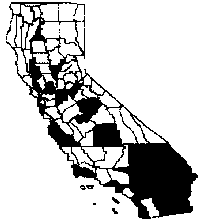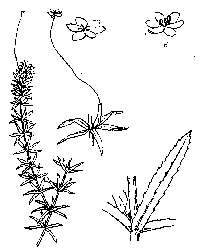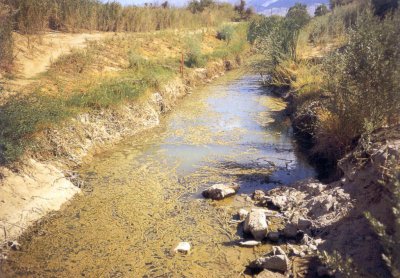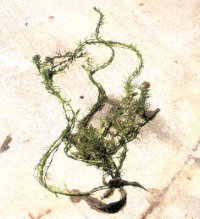|
Hydrilla verticillata
|
|
|
|
Scientific name
|
Hydrilla verticillata
|
|
Additional name information:
|
(L.f.) Caspary
|
|
Common name
|
hydrilla, water thyme, Florida elodea
|
|
Synonymous scientific names
|
Hottonia serrata, Hydrilla angustifolia, H. dentata, H. ovalifolia, H. wightii, Leptanthes verticillatus, Serpicula verticillata, Vallisneria verticillata
|
|
Closely related California natives
|
0
|
|
Closely related California non-natives:
|
0
|
|
Listed
|
CalEPPC Red Alert,CDFA A
|
|
By:
|
Kris Godfrey
|
|
Distribution
|
|
|
HOW DO I RECOGNIZE IT?
Distinctive features:
|
Hydrilla (Hydrilla verticillata) is
a perennial, submersed aquatic plant, consisting of a series of individual green
stems that bear tightly packed whorls of two to eight triangular leaves at each
node. It has small leaf scales at the base of each leaf that can be seen with
10x magnification. The spear-shaped leaves are about five to seven times as long
as wide, with serrated leaf margins and small spines on the lower surface of the
leaf midrib. Hydrilla produces distinctive subterranean vegetative propagules
(tubers) and swollen shoots (turions) in its leaf axils (Anderson
1987).
åÊ
|
|
Description:
|
| Hydrocharitaceae. Perennial aquatic. Stems: erect and elongate from rhizomes; may branch extensively; produces tuber-like rhizomes that spread horizontally. Leaves: small, oblong or spear-shaped, 0.38-0.75 in (1-2 cm) long and 0.06-0.08 in (1.5-2 mm) wide, arranged in whorls with generally 2-8 leaves per whorl; leaf margin serrate; midrib may have small spines or tooth-like conic bumps. Inflorescence: flowers solitary and inconspicuous. Flowers: there are two biotypes of hydrilla: dioecious (staminate and pistillate flowers on different plants) and monoecious (staminate and pistillate flowers on same plant); both occur in California. |
|
Staminate flowers (male) are deciduous,
free-floating, perianth in 2 whorls, each with 3 parts; 3 stamens present,
0.12-0.2 in (3-5 mm). The pistillate flowers are persistent, floating, perianth
in 2 whorls each with 3 parts, 3 stigmas. Fruit: cylindrical; 0.2-0.5 in (5-13
mm) long,
åÊ
|
|
WHERE WOULD I FIND IT?
|
Hydrilla is capable of infesting
any freshwater aquatic system in California. It has been observed in the Mojave
and Colorado deserts, south and central coasts, San Francisco Bay Area, and
Central Valley. Currently, isolated infestations of hydrilla are found in Shasta,
Yuba, Lake, Calaveras, Madera, Mariposa, and Imperial counties. Typically, it is
found in shallow(
|
|
WHERE DID IT COME FROM AND HOW IS IT SPREAD?
|
Hydrilla is thought to have been brought
into the United States from Eurasia, its native region, as an aquarium plant. It
is endemic to Asia, southern Europe, and Africa and has naturalized in the South
Pacific and Australia. It escaped from aquaria in the 1950s and 1960s (Balcuinas
1985) and was first found in California in Yuba County in fall 1976 (California
Department of Food and Agriculture 1991). Hydrilla spreads mainly by stem
fragmentation and sprouting from tubers and turions that break free of parent
plants. Monoecious hydrilla, present but rare in the United States, can produce
seed (Sutton and Van 1992).
|
|
WHAT PROBLEMS DOES IT CAUSE?
|
Hydrilla forms large mats that fill the
water column and can block or severely restrict water flow. Physical blockage
reduces recreational quality (e.g., swimming and boating) of infested water
systems, crowds out native plants, decreases habitat for fish and other
wildlife, degrades water quality, and slows water flow in canals, thereby
increasing sedimentation rates and impairing irrigation and drainage (Anderson
1987, Langeland 1990). Hydrilla is easily spread by people (e.g., by fragments
on boats or fishing equipment) or by wildlife. Once established, it produces a
bank of tubers and turions in the soil that may remain viable for three to five
years (Van and Steward 1990, Anderson et al. 1992).
åÊ
|
|
HOW DOES IT GROW AND REPRODUCE?
|
Hydrilla reproduces primarily by vegetative means in the United States. It can reproduce by fragmentation of stems, rhizomes (underground stems), and root crowns, and by the production of tubers and turions. A single viable node can produce stems and rhizomes, leading to production of an independent plant. Tubers are produced from stem tissue beneath the surface of the sediments. Turions are produced on the terminal portion of stems containing leaves (Anderson 1987). Monoecious hydrilla is also capable of producing seed, although seedlings have never been observed in a natural setting in the United States (Anderson 1987).
|
Although it is a perennial, hydrilla acts like an annual. Dieback of above-ground portions of the plant usually occurs in late fall and winter. In spring, when water temperatures exceed 59 degrees F (15 degrees C), hydrilla begins to grow, producing large amounts of biomass by late summer and early fall (Anderson 1987).
|
(click on photos to view larger image)
|
Tubers and turions also begin to sprout,
forming new plants when sediment temperatures rise (Haller et al. 1976).
Dioecious and monoecious hydrilla have different growth patterns. Dioecious
hydrilla stems elongate rapidly to form a dense canopy in the water column; once
the canopy is formed, plants spread horizontally by producing rhizomes.
Monoecious hydrilla spreads horizontally across the sediments by producing
rhizomes and new root crowns; stems then elongate and form a canopy in the water
column (Anderson 1987).
åÊ
|
|
HOW CAN I GET RID OF IT?
|
Hydrilla is a CDFA A-rated noxious weed and
is targeted for eradication whenever it is found in California. By law hydrilla
eradication efforts are the responsibility of state and county governments.
Suspected infestations of hydrilla should be reported to the local county
agricultural commissionerÛªs office. Once its presence has been confirmed,
eradication efforts will be coordinated by the CDFA Integrated Pest Control
Branch. The first action is to quarantine the infested aquatic system to
minimize risk of further spread. Where possible, this includes temporarily
closing the area to all traffic (e.g. boaters, campers, hikers). When it is not
possible to close the area, an intensive education and inspection effort is
undertaken to minimize spread of hydrilla fragments, tubers, or turions.
Methods used to control and eradicate hydrilla vary with the
size and condition of the infestation and the environmental sensitivity of the
area. If the infestation consists of just a few plants, divers may be used to
harvest and dispose of above-ground and below-ground plant parts. Herbicides may
be applied to larger infestations or, where possible, the entire system may be
drained and dredged. Dredged spoils and the sediments remaining in the system
are then fumigated with a soil sterilant. Sterile, triploid grass carp
(Ctenopharyngodon idella), a hydrilla-eating fish, were used along with
harvesting, herbicides, and dredging to eradicate a large infestation in the
Imperial Irrigation District. Grass carp are not available for general use in
California because of concerns that they could displace native fish. Thus far
they have been approved for use only in the Imperial Irrigation
District.
åÊ
|




